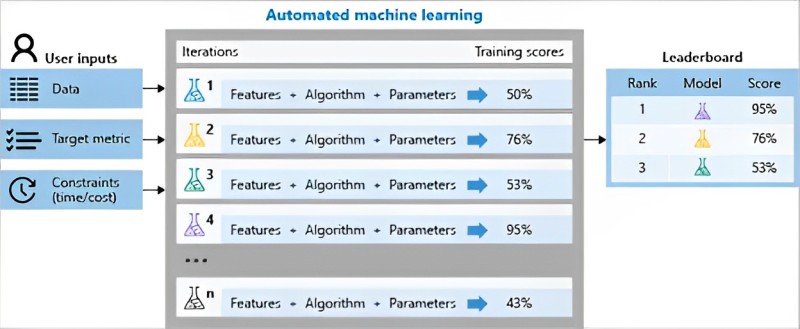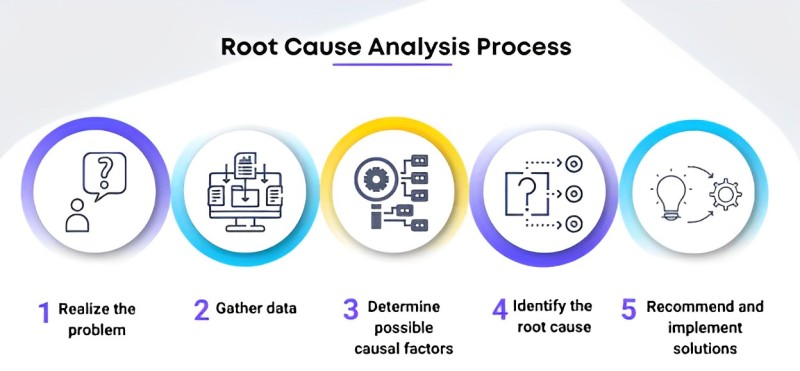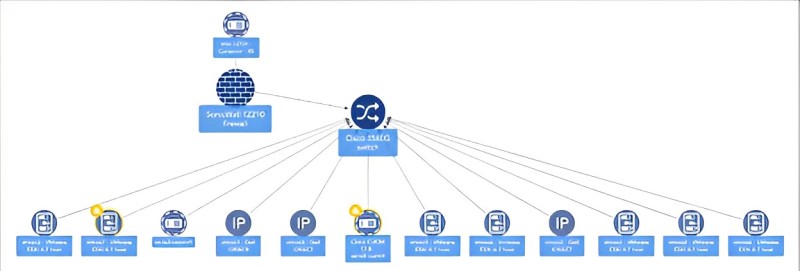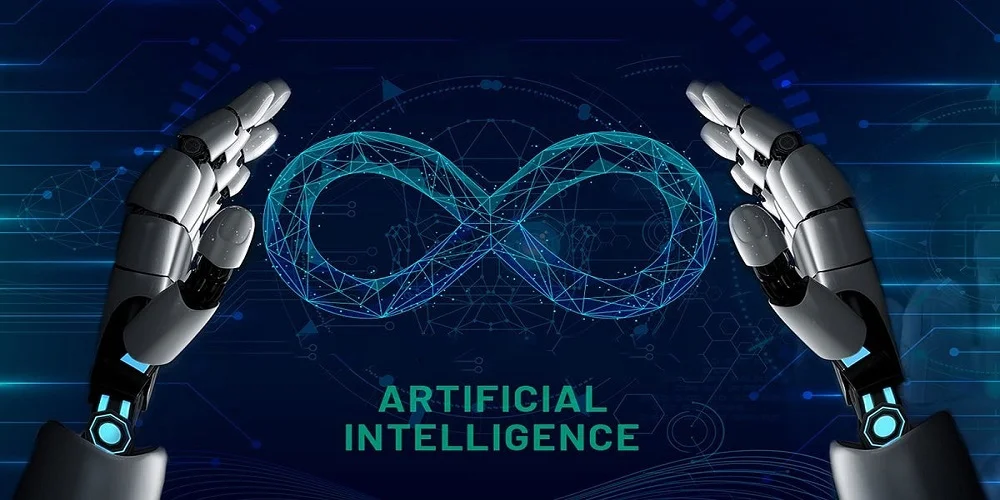
ML Supercharges Your Azure
It is building and delivering software faster. That’s the dream driving DevOps. But constant demands for new features and fixes strain even the best teams.
What if AI launches you into a new era of DevOps & Azure?
One where machine learning handles tedious tasks, freeing you to innovate?
This blog reveals how injecting smart algorithms into Azure Pipelines unlocks a force multiplier effect. We’ll tour cutting-edge AI capabilities now available from Microsoft’s cloud, with real company examples showing transformative impacts.
You’ll leave ready to supercharge your pipelines with machine learning and take a big leap towards the hyper-automated DevOps of the future.
Automating Testing with Azure Machine Learning
Rigorous testing is essential, but also painstaking. Can AI help? With Azure Machine learning, absolutely.
Its test automation services tools save hours of manual work, improve coverage, and apply AI-powered analysis for deeper insights:
UI Testing Automation
Quickly create reliable test cases that interact with application user interfaces at scale across platforms. Machine learning speeds up authoring and identifies gaps.
Load & Performance Testing
Generate realistic user load patterns and identify performance bottlenecks. The AI continually customizes the load to maximize app readiness.
Exploratory Testing
Combining computer vision and natural language processing allows virtual users to explore systems hands-free and detect defects unlikely to be found manually.
Root Cause Analysis

Algorithms comb through test run history to detect failure patterns. They automatically flag code faults and the commits likely responsible for aiding rapid repair.
Machine learning allows more rigorous, regular, and reproducible testing cycles. Bugs are eliminated faster. And effort testing every build falls dramatically.
Monitoring & Observability with AI Ops

Today’s systems comprise interdependent Microservices making behavior hard to track.
AI Ops solutions in Azure ingest telemetry data and leverage clustering, classification, and forecasting algorithms to spot emerging performance anomalies and their causes:
Performance Gradients
Machine learning baselines normal operating gradients for critical metrics. When unusual flat lines or spikes occur, issues get flagged before creating downstream disruption.
Topology Mapping

Automated dependency mapping visualizes how distributed services communicate and influence each other. Performance patterns detected by AI here help pinpoint the root of problems.
Incident Clustering
Common incident characteristics like error codes and traces get grouped by unsupervised learning. Assigning issues to known clusters speeds problem resolution.
Failure Prediction
Predictive analytics examine event sequences to determine when failures are likely to occur even without obvious symptoms. Getting ahead of failures reduces customer impact.
With AI continually assessing interdependencies and patterns, problems surface faster and service reliability improves.
ML-Fueled CI/CD Pipelines
Maximizing developer productivity means keeping them in code, and not bogged down managing builds and deployments.
Azure Pipelines’ automation, tasks, and templates help by codifying pipelines. Adding ML intelligence takes it further:
Semantic Code Search
Machine reading of repositories lets developers query code by function rather than syntax. They find and reuse what they need faster.
Automated Code Reviews
Bots analyze new code against quality rules and reference documents. They flag violated standards, suggest improvements, and even provide fixes.
AU Pair Programming
Digital assistants enhance developer productivity with context-aware recommendations. The surface code examples, best practices, and documentation as developers work.
Failure Prediction
Scanning commit history, code quality metrics, dependency graphs, and more can foresee builds likely to fail or cause production incidents. Extra controls get triggered appropriately.
Automated Testing
Executing reliability testing like chaos engineering against proposed changes predicts how safe they are for production. Unsafe changes get automatically rejected.
With coding accelerated and build safety boosted by ML developers push innovations faster while avoiding risks.
Automating Security with ML

Today’s software faces an endless barrage of cyber threats. Azure Machine Learning gives security teams a critical edge through AI that automatically hardens applications:
Adaptive Authentication
Behavioral biometrics built from each user’s unique patterns allow continuous, non-intrusive authentication. Anomalies suggest compromised credentials.
User Access Reviews
Natural language processing parses access review data and activity logs to uncover risks. Which users have unnecessary access? Are separated employees still active?
Vulnerability Assessment
Dynamic application security testing proactively finds holes through fuzzing, scanning, and behavioral analysis. Algorithms evolve tests to maximize coverage and evade detection.
Threat Hunting
Unsupervised learning detects attack payloads and patterns across network traffic that evade traditional rules. Clustering reveals novel threats for tighter containment.
Attack Simulation
Reinforcement learning allows realistic attack scenarios to be regularly simulated without actual compromise. This builds organizational resilience through practice.
The AI’s tireless vigilance foils attacks while creating robust feedback loops so defenses continually improve. You get the comprehensive protection today’s threat landscape demands.
Smattering Cost Optimization

Cloud convenience can accidentally drive overspending. Azure Machine Learning applies analytical intelligence to predict resourcing needs and optimize costs:
Usage Forecasting
Time series analysis on usage data improves predictions of where and when capacity is needed. More accurate provisioning reduces waste.
Reserved Instance Planning
Algorithms process workload timelines, usage bursts, and pipeline schedules to recommend where reserved capacity offers savings over on-demand pricing.
Resource Right-Sizing
As code moves through pipelines, machine learning taps performance benchmarks to guide optimal VM types, cores, and memory for each environment. The most cost-efficient resources get provisioned.
Budget Enforcement
Natural language interfaces allow nuanced budget definition and tracking. Users get notifications as spending thresholds approach, preventing surprise overages.
Continuous cost optimization ensures budgets balance performance needs. And spending visibility improves through ML-generated insights.
Advancing Accessibility
Inclusive software serves every user’s needs. Microsoft Azure DevOps Solutions helps assess and enhance accessibility:
Product Scanning
Computer vision analyzes application UI/UX against accessibility guidelines. Automated journeys reveal usability barriers for refinement.
Code Scanning
The static analysis extends to surface areas like alt text, color contrast, and headings structure. Feedback gets incorporated into QA gates.
User Studies
Capturing impressions via ML sentiment and speech analysis during over-the-shoulder or remote user testing highlights areas for improvement.
Accessibility Testing Labs
Reinforcement learning trains AI testers on assistive interfaces like screen readers. They explore applications while developers observe friction points.
Rooting out exclusion boosts customer satisfaction and unlocks underserved markets.
Streamlining Compliance
Staying compliant with regulations like GDPR is demanding. AI again helps by continuously reviewing:
Data Mapping
Natural language processing parses policies to create allow/deny lists for data usage. Misuse gets blocked automatically.
Training Systems
Speech analysis during security awareness training determines who needs reinforcement. Personalized refreshers use chatbots.
Activity Audits
Unsupervised anomaly detection reviews access logs for unusual patterns suggesting improper data handling. Ethics reviews are initiated if detected.
Control Testing
Orchestrating attacks on systems checks if protective controls work as intended. Failures trigger required strengthening.
Integrating compliance into pipelines reduces the human oversight needed. Prompt issue discovery better protects customers.
Informing Strategy with MLOps
Machine learning handles individual tasks well. However, improving organizational outcomes takes modeling complex business challenges. MLOps apply analytics for strategic insights:
Data Benchmarking
Cleaning data and then running statistical analyses against KPIs highlights what’s moving key metrics. Replicating positive patterns and avoiding negative ones guides planning.
Predictive Workforce Models
Forecasting team growth, project queues, attrition rates, and costs yield clearer long-term budgeting for executives.
Customer Analytics
Sentiment analysis, churn models, and other techniques continuously evaluate satisfaction. Product experiences constantly improve.
Macro Trend Analysis
Processing industry news, financial reports, technology surveys, and more reveals external forces likely to impact adoption and roadmaps.
With an MLOps pulse on all business factors, data-driven decisions unlock new levels of speed and performance.
Boosting Productivity with MLOps
Keeping developers focused on writing code is key to productivity. MLOps in Microsoft Azure DevOps Solutions handles distracting tasks so innovation keeps flowing:
Proactively flagging process issues lets teams improve system reliability. Unsupervised anomaly detection across application performance metrics spots problems emerging.
Degraded response times, spikes in errors, and disk usage changes all become alerts before impacting users.
Teams also save hours manually reviewing logs thanks to intelligent parsing.
Natural language queries allow asking simply, “Show me what’s causing the user login delays” and AI surfaces the most relevant associated events, metrics, and traces.
Personalized guidance also prevents developer roadblocks. A digital assistant plugs knowledge gaps just in time as code gets written.
It suggests design pattern improvements after scanning your codebase’s best practices.
Or noting difficulties attempting a workflow, it recommends alternative APIs with less friction backed by data-driven benchmarks.
Upskilling happens continuously through the tools teams already use.
Generating synthetic test datasets speeds up preparation for experimentation and model training.
Simply specify parameters like data types, variability, and privacy requirements through a simple interface.
Behind the scenes, generative adversarial networks produce artificial samples mimicking real-world data distributions.
This workflow automation means data scientists spend less time on tedious data wrangling.
Optimizing Cloud Costs
Running systems round-the-clock quickly gets expensive. But where can costs be reduced safely? MLOps has answers:
Forecasting upcoming demand based on past seasonal patterns allows intelligently pre-purchasing discounted reserved instances.
More accurate provisioning means fewer expensive on-demand instances are required.
Saving over 50% is possible. Applying similar forecasts ensures test and staging environments appropriately mimic production traffic as well.
Yet they lean the rest of the time preventing waste.
Prescriptive optimization takes cost reduction further. Machine learning crawls configuration and load testing services to right-size everything.
Scaling resource quantities, sizes, and features to the least necessary for each system’s typical usage minimizes expenses. Performance efficiency improves too thanks to removing unnecessary capacity.
Anomaly detection also triggers cost-saving responses automatically.
Recognizing usage spikes inconsistent with forecasts prompts notifications to suggest shifting workloads on-peak times. Or autoscaling rules might roll over capacity temporarily until demand stabilizes again.
Being proactive avoids otherwise manual scrambles during volatile conditions.
With prediction driving planning, and automation responding 24/7, cloud costs stay efficient continuously.
Streamlining Compliance Reviews
Staying current with ever-evolving regulations like GDPR is tedious without help. MLOps in Azure relieves the burden:
Mapping data flows and cataloging systems containing protected information gets accelerated by natural language processing.
Poring over manuals and specs becomes fast keyword searches instead. And auto-generated data hierarchies visualize relationships, making gap discovery simpler.
Automatically validating controls through orchestrated attack simulations replaces manual questionnaires.
MLOps routines impersonate bad actors trying to access data or systems—attempts made to demonstrate if controls fail.
Any successful breaches automatically trigger alerts for the issues that require remediation before audits.
Unsupervised learning also uncovers unusual usage patterns that might violate policies.
Recognizing spikes in external data sharing, unauthorized access levels being enabled, or privileges elevating raises red flags.
Additional user training is recommended when policy knowledge appears lacking.
Ongoing assistance from MLOps reduces overburdened compliance teams’ manual effort significantly. Critical protections stay reliable through continual reinforcement.
Accelerating Software Delivery
Balancing speed with quality has always challenged IT leaders. MLOps inside Microsoft Azure DevOps Solutions provides a competitive edge:
Test automation reduces validation timelines before releases. AI agents explore application functionality faster than manual workflows allow.
Generating test datasets on-demand also removes wait times. Taken together, code reaches production measurably sooner.
Advanced warnings about likely defects prevent release delays later.
Algorithms analyzing past failures, code quality metrics, and application complexity predict what will break beforehand. Failures become exceptions rather than surprises.
Automating rollouts accelerates software delivery further. Canary deployments check performance and catch bugs affecting only subsets of users.
Confirmed safe, managed ramp-ups to full production continue. Rollbacks likewise happen automatically if issues emerge.
Continuous experimentation powered by MLOps provides ongoing performance boosts post-release.
Trying interface variations, evaluating feature enablement rates, and customizing experiences for each customer reveal optimum configurations.
Users ultimately enjoy the best application refinements thanks to silently running ML optimization behind the scenes.
With testing automated, deployments streamlined, and production optimized by algorithms around the clock, releasing innovations enters a new era of velocity.
The complexity of modern software demands AI’s advanced reasoning for robust operations. Cloud-hosted machine learning makes maturing solutions accessible to every organization.
By democratizing AI’s benefits, Azure Pipelines and Azure Machine Learning help lead all developers into a smarter DevOps future.
What part of machine learning for DevOps excites you most? Which use cases would your teams find most valuable today?
We welcome your perspectives and questions in the comments.



